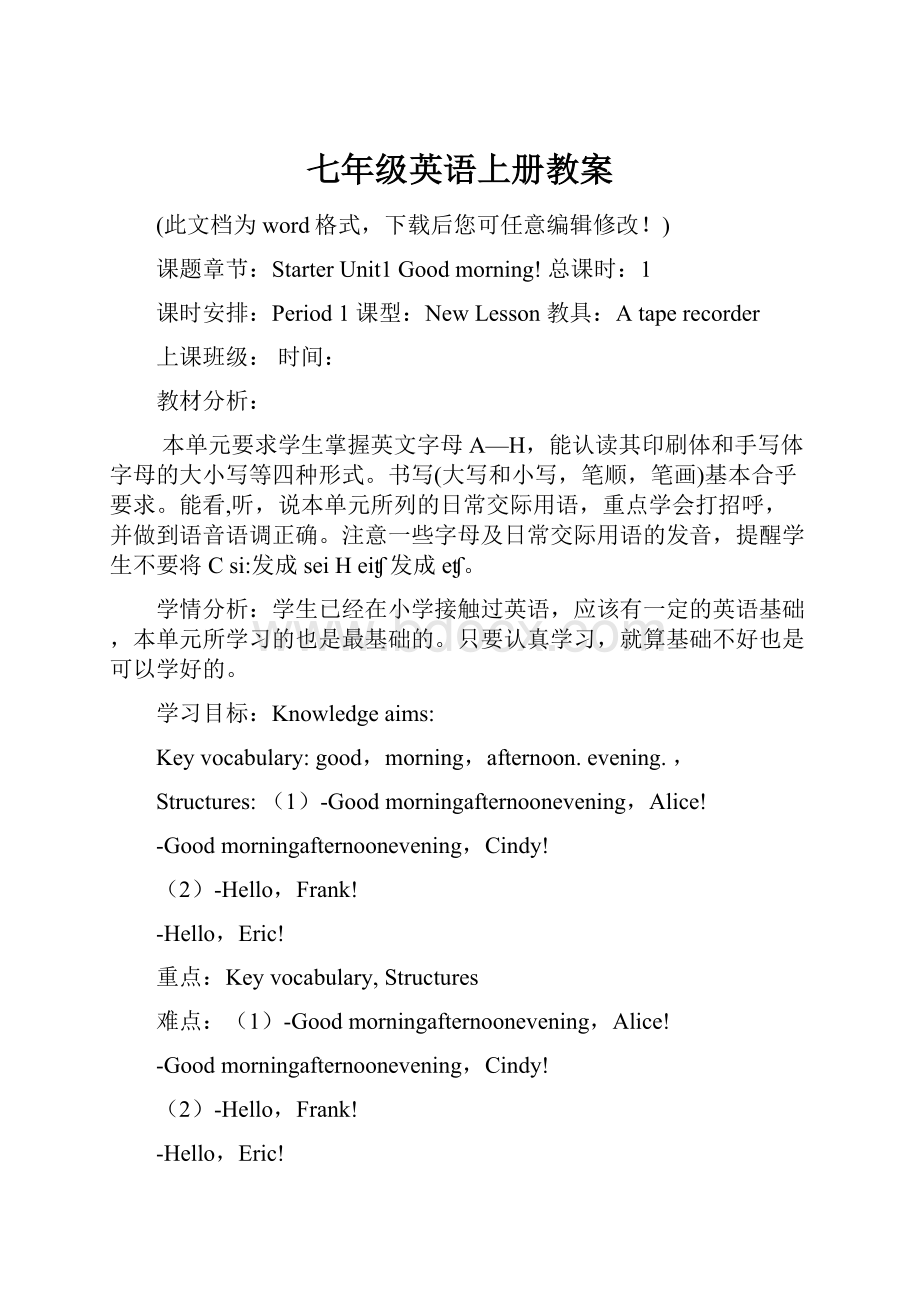七年级英语上册教案.docx
《七年级英语上册教案.docx》由会员分享,可在线阅读,更多相关《七年级英语上册教案.docx(22页珍藏版)》请在冰豆网上搜索。

七年级英语上册教案
(此文档为word格式,下载后您可任意编辑修改!
)
课题章节:
StarterUnit1Goodmorning!
总课时:
1
课时安排:
Period1课型:
NewLesson教具:
Ataperecorder
上课班级:
时间:
教材分析:
本单元要求学生掌握英文字母A—H,能认读其印刷体和手写体字母的大小写等四种形式。
书写(大写和小写,笔顺,笔画)基本合乎要求。
能看,听,说本单元所列的日常交际用语,重点学会打招呼,并做到语音语调正确。
注意一些字母及日常交际用语的发音,提醒学生不要将Csi:
发成seiHeiʧ发成eʧ。
学情分析:
学生已经在小学接触过英语,应该有一定的英语基础,本单元所学习的也是最基础的。
只要认真学习,就算基础不好也是可以学好的。
学习目标:
Knowledgeaims:
Keyvocabulary:
good,morning,afternoon.evening.,
Structures:
(1)-Goodmorningafternoonevening,Alice!
-Goodmorningafternoonevening,Cindy!
(2)-Hello,Frank!
-Hello,Eric!
重点:
Keyvocabulary,Structures
难点:
(1)-Goodmorningafternoonevening,Alice!
-Goodmorningafternoonevening,Cindy!
(2)-Hello,Frank!
-Hello,Eric!
处理方法:
Situationsimulatingmethod,communicativemethod,
task-basedmethod.
教学过程:
(Teachingprocedures)
Step1Learningaims:
学习目标
1.掌握下列生词和人名:
Newwords(新单词):
good,morning,afternoon.evening.
2.掌握重点句型:
(1)-Goodmorningafternoonevening,Alice!
-Goodmorningafternoonevening,Cindy!
(2)-Hello,Frank!
-Hello,Eric!
Step2Guideofself-learning:
自学指导
1.Learnthenamesofnewfriendswithpictures.
通过图片来记忆新朋友的名字。
2.Learnthenewwords:
morning,afternoon,evening.
通过图片学习新单词:
早上,下午,晚上
3.Makeanewconversationingroupaccordingto1a.2mins
小组合作编新对话,看看哪一个小组编的最好,时间2分钟。
Step3Leadingin
--Goodmorning,boysandgirls!
I’mGuoZhihua.I’mgladtoteachyourEnglishinthisnewterm.AndIwanttobefriendswithyou.SoIloveandstudyEnglish.
Step4Learningthenamesofseveralfriends.
1.Showthenames,andreadafterteacherseveraltimes.
2.2minstorememberthenames.
3.Teacheraskstudentsanswerquickly.
4.Letstudentswritedownthenamesaccordingtotheorderofthefirstletter.
Step5Learningthewords.
1.Lookatthepicture:
Whenisit?
2.Readafterteacherandremember.
3.Playagame.Guesswhenisit?
4.Practiceitbythemselves.
5.Makeashortconversation.
Step6Learning1a.
1.Listentothetapetwiceandreadafterthetape.
2.2minstoread1aandtrytorecite.
3.Choosestudentstoreciteit.
4.Pairwork.Workinpairstomakepredictionsaccordingtothesample.
5.Askseveralpairstosharetheirconversationstotheclass.
Step7Summingup(总结)
1.Getthestudentstosumupwhattheytheclass.
Havesomestudentstelltheclasswhatthey.
2.WritethelettersfromAatoHh.
当堂训练:
一.补充下列句子。
1.---__________,Eric!
---Hello,Helen!
2.---Goodmorning,Bob.
---Good________,Helen.
3.---_____________,Frank.
---Goodevening,Dale.
4.---Goodafternoon,Eric.
---_____________,Grace.
二.汉译英:
1.嗨,艾丽斯!
2.早上好,戴尔。
3.晚上好,埃里克。
课后反思:
课题章节:
StarterUnit1Goodmorning!
总课时:
2
课时安排:
Period2课型:
NewLesson教具:
Ataperecorder
上课班级:
时间:
教材分析:
本单元要求学生掌握英文字母A—H,能认读其印刷体和手写体字母的大小写等四种形式。
书写(大写和小写,笔顺,笔画)基本合乎要求。
能看,听,说本单元所列的日常交际用语,重点学会打招呼,并做到语音语调正确。
注意一些字母及日常交际用语的发音,提醒学生不要将Csi:
发成seiHeiʧ发成eʧ。
学情分析:
学生已经在小学接触过英语,应该有一定的英语基础,本单元所学习的也是最基础的。
只要认真学习,就算基础不好也是可以学好的。
学习目标:
Knowledgeaims:
Keyletters:
Aa,Bb,Cc,Dd,Ee,Ff,Gg,Hh
Keyvocabulary:
HB,CD,BBC
重点:
Keyletters.
难点:
thewritingandthepronunciationoftheletters.
处理方法:
Situationsimulatingmethod,communicativemethod,
task-basedmethod.
教学过程:
(Teachingprocedures)
Step1Learningaims:
学习目标
1、CanreadthelettersA-Hfluently.
2、CanwritethelettersA-Hcorrectly.
3﹑Canmatchthebiglettersandsmallletters.
Step2Guideofself-learning:
自学指导
1.Readtheletterswithyourpartner,payattentiontothepronunciation,findoutwhichgroupisbest.2mins
2.Lookthewritingoftheletters,thenwritethemonyourexercisebook,3minslaterchooseseveralSswriteontheblackboard,andfindoutwhoisbest.
Step3Leadingin
Greetstudentsandaskthemtogreeteachother.
--Goodmorning,LinTao!
--Goodmorning!
--I’mMissGuo.What’syourname?
--I’mLiHao.
--Nicetomeetyou!
--…
Step4Learningtheletters.
1.Learnthereadingoftheletters.
(1).Readafterthetape.
(2).Readbythemselves2mins.
(3)Readtotheirdeskmate.
(4)Readtogether.
(5)Choosestudentstoreadandcorrectthemistake.
2.Learnthewritingoftheletters.
(1)Looktheblackboard.
(2)Writeontheirexercisesbook.
(3)Checkwiththeirpartner.
(4)Chooseseveralstudentstowriteontheblackboardandcorrectthemistake.
Step5Listening2a,2c.
1.ReadtheinstructionstoSs.
2.Playthetapetwice.
3.Playthetapeathirdtime.Atthesametime,checktheanswers.
Step6Learning3
1.Guessthemeaningofthewords.
2.Teachertellthem,2minstoremember.
3.Toteachertheotherwords.
Step8Summingup(总结)
1.Getthestudentstosumupwhattheytheclass.
2.Promptsomestudentstelltheclasswhatthey,andthenewwords.
2.Practicethesentencesafterclass.
当堂训练:
一、在所学字母中,我学会了两个元音字母:
二、写出所学字母中由三笔完成的大写字母:
三、写出所学字母中由一笔完成的小写字母:
四、完成下列单词的缩写形式:
1.(铅笔芯)硬黑
2.光盘
3.英国广播公司
课后反思:
课题章节:
StarterUnit1Goodmorning!
总课时:
3
课时安排:
Period3课型:
NewLesson教具:
Ataperecorder
上课班级:
时间:
教材分析:
本单元要求学生掌握英文字母A—H,能认读其印刷体和手写体字母的大小写等四种形式。
书写(大写和小写,笔顺,笔画)基本合乎要求。
能看,听,说本单元所列的日常交际用语,重点学会打招呼,并做到语音语调正确。
注意一些字母及日常交际用语的发音,提醒学生不要将Csi:
发成seiHeiʧ发成eʧ。
学情分析:
学生已经在小学接触过英语,应该有一定的英语基础,本单元所学习的也是最基础的。
只要认真学习,就算基础不好也是可以学好的。
学习目标:
Knowledgeaims:
Keyvocabulary:
simulatingmethod,communicativemethod,
task-basedmethod.
教学过程:
(Teachingprocedures)
Step1Learningaims:
学习目标
1.复习SectionA部分的内容,
2.掌握8个新单词:
andreviewthegreetings.3mins.
2.Readtheconversationwithyoupartnerandtrytoreciteit,findwhoisbest.5mins.
Step3Leadingin
--Hello!
--Hi!
--Howareyou?
--Fine,thankyou.Andtothetapetwiceandreadafterthetape.
2.2minstoread3andtrytorecite.
3.Choosestudentstoreciteit.
4.Pairwork.Workinpairstomakepredictionsaccordingtothesample.
5.Askseveralpairstosharetheirconversationstotheclass.
Step7Summingup(总结)
1.Getthestudentstosumupwhattheytheclass.
2.Havesomestudentstelltheclasswhatthey.
3.WritethelettersfromOotoTt.
当堂训练:
选择正确答案
1.-Howareyou?
-________
A.Thankyou.B.Verywell.C.Fine,thankyou
2.-_________
-Nicetomeetyou,too.
A.Howareyou?
B.Nicetomeetyou.C.I’mfine,too.
3.–Goodafternoon.
-___________.
A.GoodmorningB.Goodafternoon.C.Thankyou.
4.-Thankyou!
-________.
A.You’rewelcomeB.SorryC.I’mfine
5.–Hello!
-_____.
A.HelloB.ThankyouC.HowareyouD.That’sallright
课后反思:
课题章节:
StarterUnit1Goodmorning!
总课时:
4
课时安排:
Period4课型:
NewLesson教具:
Ataperecorder
上课班级:
时间:
教材分析:
本单元要求学生掌握英文字母A—H,能认读其印刷体和手写体字母的大
小写等四种形式。
书写(大写和小写,笔顺,笔画)基本合乎要求。
能看,听,
说本单元所列的日常交际用语,重点学会打招呼,并做到语音语调正确。
注意一些字母及日常交际用语的发音,提醒学生不要将Csi:
发成seiH
eiʧ发成eʧ。
学情分析:
学生已经在小学接触过英语,应该有一定的英语基础,本单元所学习的也是最基础的。
只要认真学习,就算基础不好也是可以学好的。
学习目标:
Knowledgeaims:
Keyvocabulary:
wordsofthisunit.
Structures:
sentencesofthisunit.
重点:
Keyvocabulary,Structures
难点:
Tousethesentencesfluently.
处理方法:
Situationsimulatingmethod,communicativemethod,
task-basedmethod.
教学过程:
(Teachingprocedures)
Step1Learningaims:
学习目标
1、ReviewlettersA-H.
2、Reviewevening.
(2)-Howareyou?
-I’mfine,thanks.
-Howareyou?
-I’mOK.
Step2Guideofself-learning:
自学指导
ReviewlettersA-H,thendosomeexercisesbyyourself.3mins.
Step3Leadingin
Askthemseveralquestions.
Step4Review.
1.RecitelettersA-H.
2.dosomeexercises.
翻译:
谢谢!
你好吗?
并说出三种回答方式。
Step5Listening3a,4,5
1.ReadtheinstructionstoSs.
2.Playthetapetwice.
3.Playthetapeathirdtime.Atthesametime,checktheanswers.
Step6Finish3b.
1.1minstodoitbythemselves.
2.checktheanswer.
Step7Summingup(总结)
1.Getthestudentstosumupwhattheytheclass.
2.Havesomestudentstelltheclasswhattheyusingthesentences.
当堂训练:
一、判断下列各组是否含有相同的元音音素,相同用S表示,不同用D表示。
AF()EG()
FH()BA()
DE()CEDGF()
AHB()EDGB()
FrankDale()
GraceAlice()
EricHelen()
二、我叫Dale,我在上午、下午、晚上分别遇到了Eric,Frank和Bob,下面是我和他们见面时的对话,每空一词。
1.-,Eric!
-,!
2.-,Frank!
-,Dale!
3.-,Bob!
-,Dale!
课后反思:
课题章节:
StarterUnit2What’sthisinEnglish?
总课时:
5
课时安排:
Period1课型:
NewLesson教具:
Ataperecorder
上课班级:
时间:
教材分析:
本单元的核心教学内容是“认物”。
用英语确认周围的常见事物比较英语初学者的实际情况。
通过本单元教学,使学生运用所学句型,去熟悉周围事物的名称;教学生学会在实际生活中如何确认事物。
通过辨认物体,学生学到一些生词,并巩固所学句型。
学情分析:
学生已经在小学接触过英语,应该有一定的英语基础,本单元所学习的也是最基础的。
只要认真学习,就算基础不好也是可以学好的。
学习目标:
Knowledgeaims:
Keyvocabulary:
what,is,this,in,English,it,aan,map,orange,jacket,key,quilt,pen,ruler,what’s=whatis,it’s=itis
Structures:
(1)-what’sthisinEnglish?
-It’sanorange.
(2)-What’sthisinEnglish?
-It’samap
重点:
Keyvocabulary,Structures
难点:
(1)-what’sthisinEnglish?
-It’sanorange.
(2)-What’sthisinEnglish?
-It’samap
处理方法:
Situationsimulatingmethod,communicativemethod,
task-basedmethod.
教学过程:
(Teachingprocedures)
Step1Learningaims:
学习目标
1Learnthenewwords:
map,orange,ruler,jacket,pen,key,quilt
2Learnthenewsentences:
What’sthisinEnglish?
It’saan……
Step2Guideofself-learning:
自学指导
1.Learnthenewwordsaccordingtothepicture.
2.Learnthenewsentencesbypairwork.
-What’sthisinEnglish?
-It’saan……
Step3Leadingin
Listentoapieceofmusic,andsingtogether.
Step4Learnthenewwords.
Havereadyaquilt,amap,ajacket,akey,aruler,apen,anorange.HoldthekeyupandsayWhat’sthisinEnglish?
It’sakey.
Repeatandthengetstudentstorepeat.Dothesamewithakey,apen,aruler.Ifpossible,useflashcardstoteachthespellingofthewords.Putaflashcardbeneathadrawingofeachobject.
Step5Learnthesentences.
1.Lookatthepicture:
Teacherask“What’sthisinEnglish?
”
Studentsanswer“It’saan……”
2.Exchangetherole.StudentsaskTeacheranswer.
4.Practiceitinpairwork.
5.Makeashortconversation.
Step6Learn1a.
Listen.Playthetapetwice.Havethe